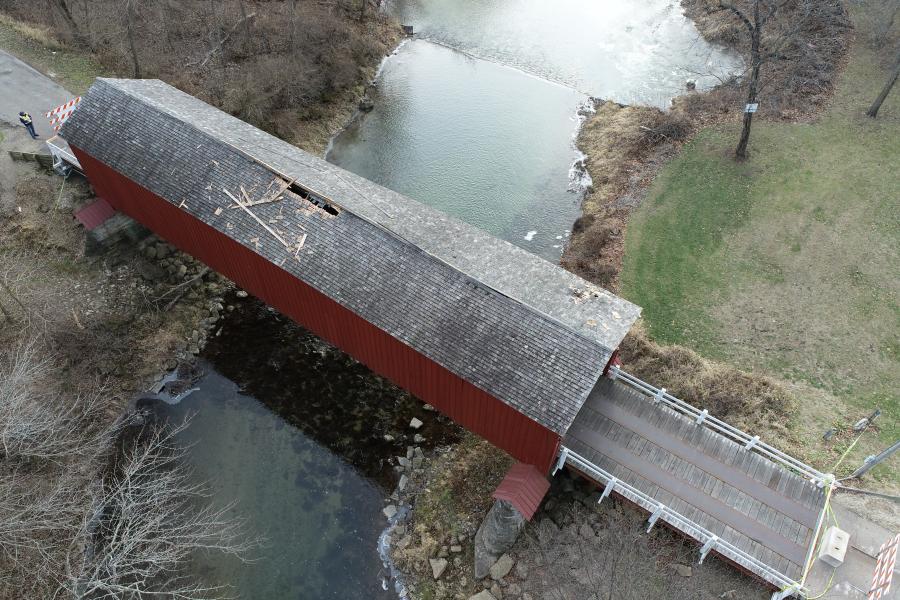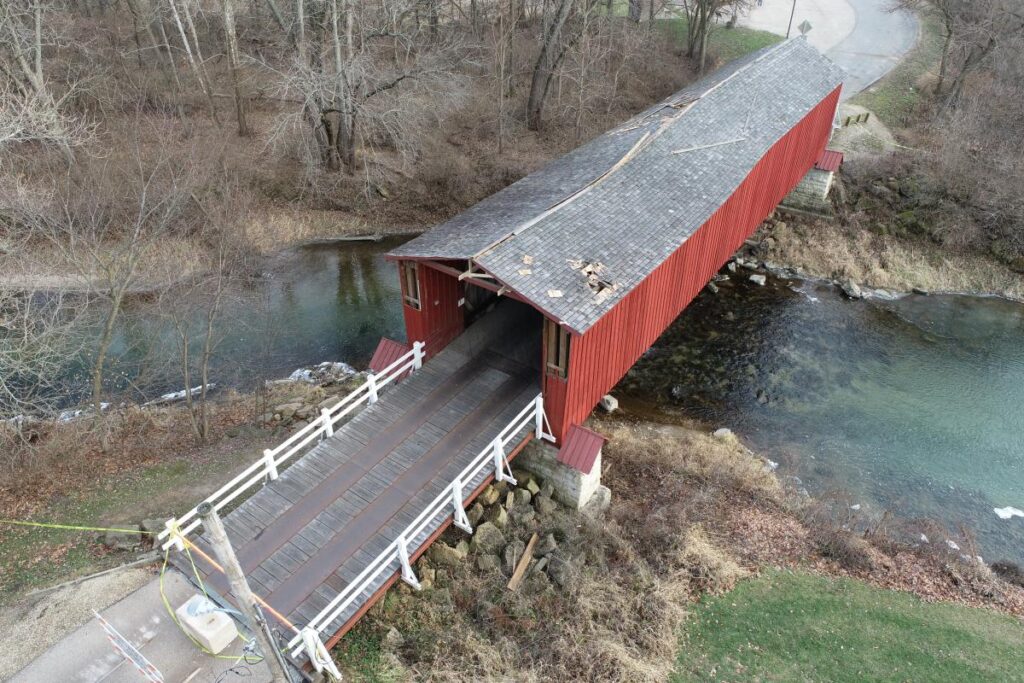Photo courtesy of Illinois Department of Transportation
As with any restoration project involving an antique, careful and meticulous planning done with respect to historic attributes will be paramount — and time consuming.


Princeton’s Red Covered Bridge has endured horse-drawn wagons, automobiles, trucks and tourists as well as serving as a picturesque backdrop for countless proms and weddings during its 160 years of existence. While the iconic bridge has survived large trucks hitting it in the past, the damage from another one in November caused by a driver trying to squeeze through the structure’s tight confines was different and much more severe.
As with any restoration project involving an antique, careful and meticulous planning done with respect to historic attributes will be paramount — and time consuming. Analyzing and determining the scope of the damage, developing a plan for repairs, programming costs and seeing through to construction likely will take years.
“Compared to any other incidents, the recent incident involved significant damage to the roof and many parts of the wooden trusses,” said Luis Calderon, bridge maintenance engineer of IDOT’s District 3 in Ottawa.
In the November incident, the semi driver attempted to drive through the north side of the 11-ft.-10-in.-tall bridge, damaging sections of the façade and roof. The impact was so strong that it ripped off the trailer roof of the semi and created a large gash through the bridge’s roof.
Calderon said an initial inspection immediately after the incident required closing the bridge to both vehicles and pedestrians. While the bridge continues to be assessed for repairs, workers from Day Labor, IDOT’s in-house construction unit, installed temporary shoring to maintain the integrity of the roof until a permanent fix can be made.
From Horse-Drawn Wagons to Horsepower
Completed in 1864 for $3,148.47, the Red Covered Bridge is a one-lane timber truss structure spanning Bureau Creek a half-mile west of Illinois 26 and a mile north of Princeton in Bureau County. The bridge replaced a pontoon bridge that would flood during high water and force travelers to traverse the river.
Oak and other lumber was shipped from Chicago to construct the bridge, one of about 200 bridges built in Illinois in the 19th century. When opened, the bridge was an important part of the Galena Trail carrying horse-drawn wagons and cattle between Peoria to Galena. The bridge posted a warning at each entrance for travelers which reads:
“Five dollar fine for driving more than 12 horses or mule or cattle at one time or for leading any beast faster than a walk on or across this bridge.”
The state later assumed control of the bridge, currently one of five state-owned covered bridges in Illinois. A 1963 state law requires the department to repair, maintain, operate, control and preserve every covered bridge in the state.
The Red Covered Bridge has been listed on the National Register of Historic Places since 1975. The bridge has one distinction over the other covered bridges in Illinois: It is the only one open to traffic. According to the most recent statistics, the bridge accommodated an average of 275 vehicles a day.
Crashes, Near Misses
The bridge survived several incidents prior to the November crash. An arsonist in 1971 attempted to burn it down. Erosion along Bureau Creek in the 1990s threatened the bridge after it damaged the Illinois 26 bridge upstream. High winds in 2003 felled a 90-ft.-tall cottonwood tree across the north side of the deck leading to the bridge but missed the main structure.
The bridge has received several upgrades in recent decades, such as a fire suppression system, lighting and a surveillance system. While these improvements have helped protect the bridge, it has not been spared from crashes involving large trucks.
Prior to the most recent crash, the last notable one was in 2021, when a semitrailer struck one of the bridge entrances. The bridge was repaired that same year. The bridge also underwent maintenance and repair work in 2022 as workers replaced the steel beams supporting the south approach to the bridge as well as cleaned and painted the steel beams for the north approach. New timber planking was added at both ends.
Unlike those prior repairs, the damage incurred in November will require more than a quick fix.
Repairing History
Calderon said IDOT’s Bridge Office typically will develop repair plans for damaged structures and bridges that either Day Labor or the district’s maintenance forces can accomplish quickly. However, these repair plans are usually smaller and do not require much coordination.
In the case of the Red Covered Bridge, the extent of the current damage requires IDOT to alter its approach.
Due to the historical significance and several involvements needed to address repairs, the District 3 program development bureau will be leading the repair and restoration efforts,” Calderon said. “Coordination with other agencies and plan details are just as important as the construction work.”
The Red Covered Bridge’s listing on the National Register of Historic Places requires additional coordination with the State Historic Preservation Office to ensure the historic aspects of the bridge are not significantly changed during the repairs, said District 3 Program Development Engineer Michael Short. Compared to a conventional bridge construction project, covered bridges are unique as they contain many wooden components.
“When working with historic structures and pavements, it’s a challenge to meet the goal of building infrastructure in the most cost-effective manner while also preserving the historic aspects of the structure or pavement,” Short said.
The path to repairing the project will require several steps:
- Development of a bridge condition report, in which a team of structural engineers will closely inspect and examine the structure and determine the extent of the necessary repairs that are the result of the crash. The inspection also will review the entire structure for typical aging of the structure over time and will include initial concepts of repair techniques.
- A phase one report to define the scope of work and a preliminary cost estimate. Additionally, this phase will include coordination with the State Historic Preservation Office, with the goal of achieving their concurrence on the proposed repairs. A phase one report typically requires 18 months to complete.
- Preparation of detailed construction plans and specifications, as well as a detailed cost estimate. This phase is expected to take 12-18 months to complete and will result in advertising a repair contract to bidders.
Short said a cost estimate is unknown until the phase one report is completed. Construction is not expected to begin for a few years.
“Since we do not know the scope of the repairs that need to be performed, we cannot predict how long it will take to make the repairs,” he added.
The Red Covered Bridge isn’t the first historical project District 3 has undertaken. In 2019 the district worked with the State Historic Preservation Office to patch a stretch of Old Route 66 between Chenoa and Pontiac in Livingston County. The $640,392 project required utilizing colored concrete and special finishing techniques to closely match it to the color and texture of the existing concrete.
Short said while these types of techniques are more expensive, they help to preserve the historic nature of the facilities. The project was honored with the “Best Historical Restoration/Preservation” project of less than $5 million from the Illinois chapter of the American Public Works Association in 2021.
“We coordinate with the State Historic Preservation Office on many projects, so we are used to working with them,” he said. “We are aware of the time they need to do their review, and plan on that when we develop our project schedule.”
Both Calderon and Short ask the public to be patient with the repair process for the Red Covered Bridge.
“This is a historic structure, and it will take time for the department to develop a plan for repairs that addresses both the structural aspects and the historic aspects of the structure,” Short said.

Photo courtesy of Illinois Department of Transportation
Read the full article here











